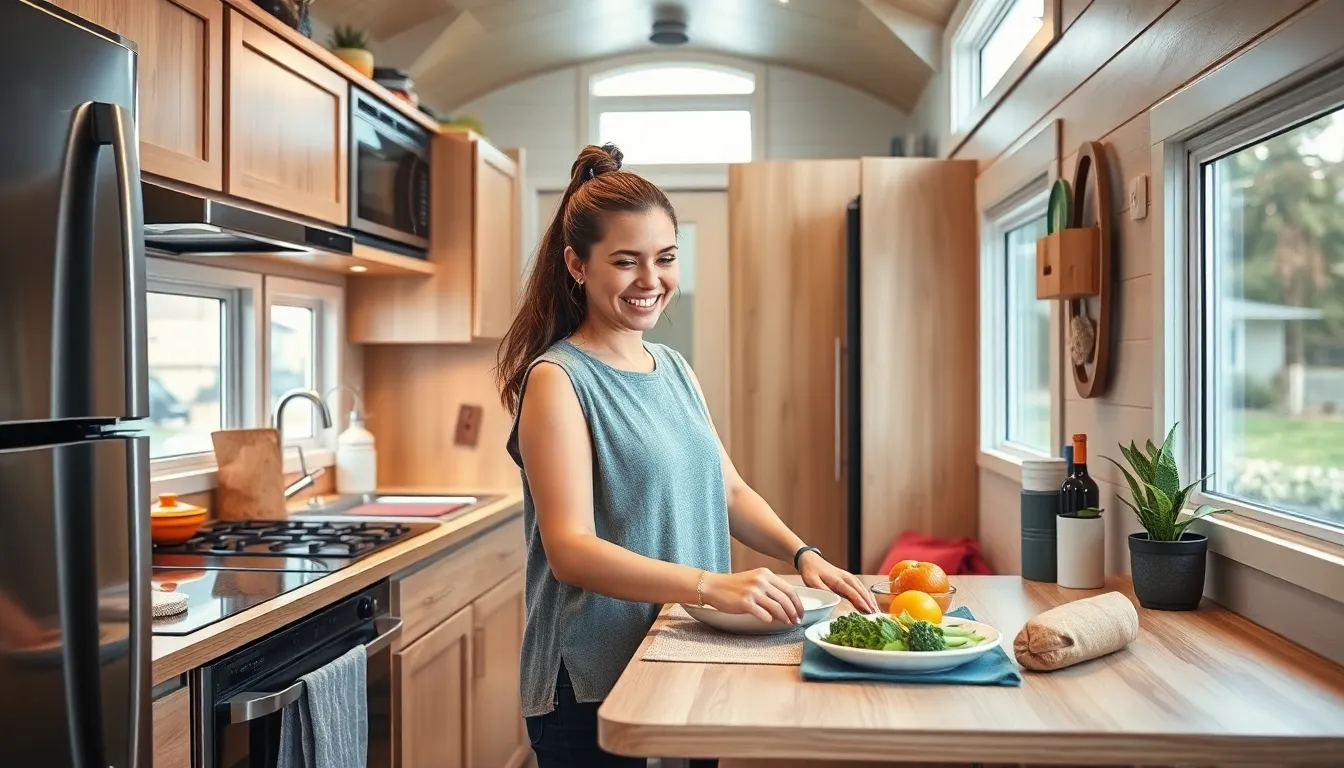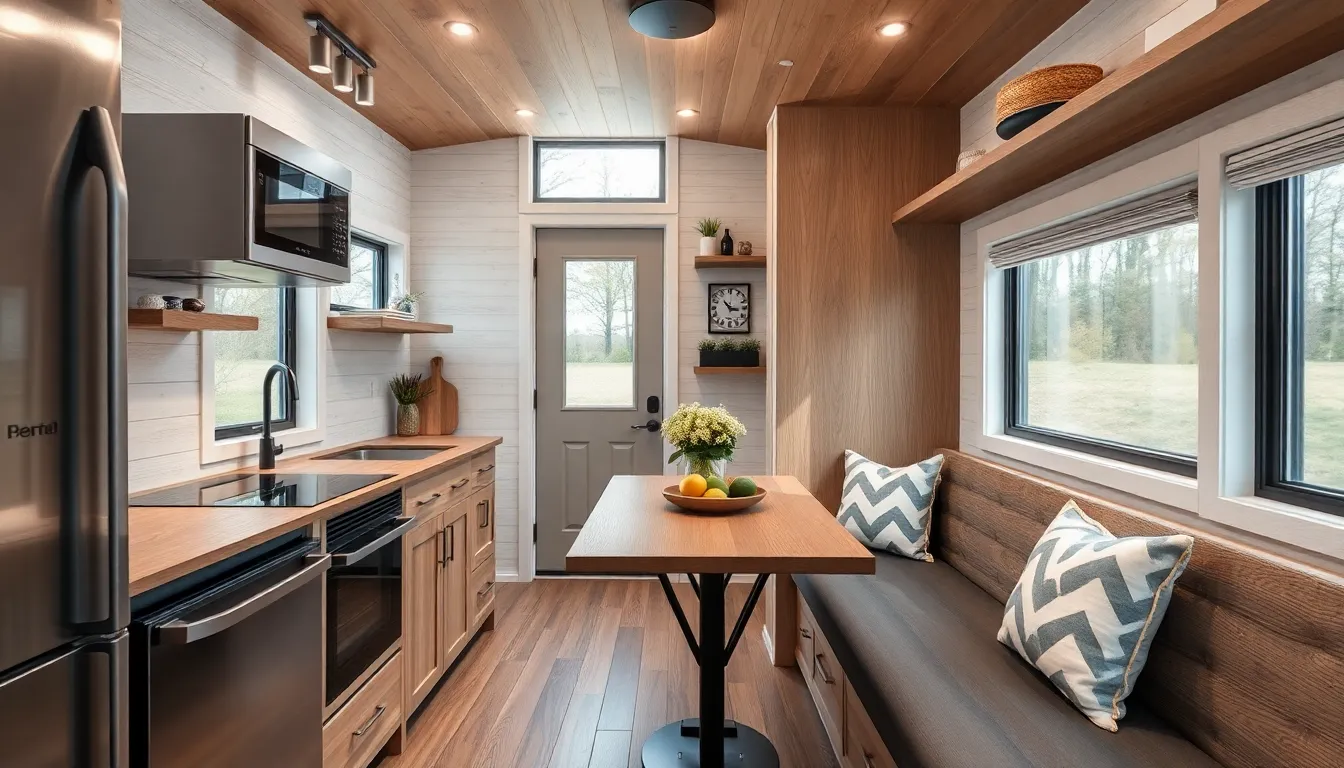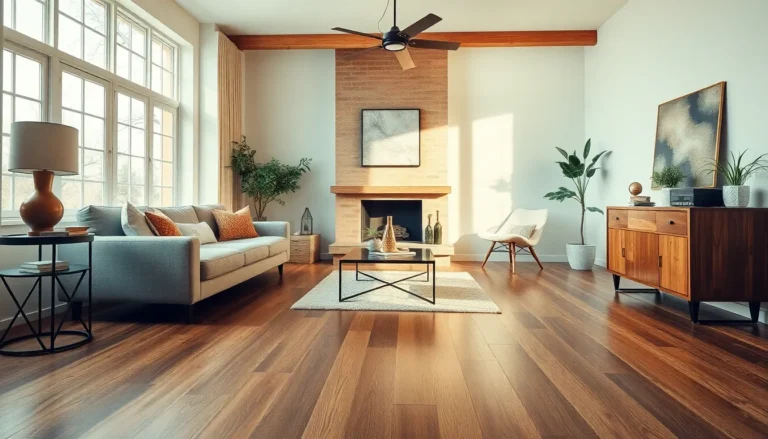Table of Contents
ToggleIn a world where bigger often means better, tiny house kitchens are flipping the script. These pint-sized culinary havens prove that you don’t need a sprawling space to whip up gourmet meals. With clever designs and multifunctional furniture, they pack a punch that would make even the most spacious kitchens green with envy.
Imagine cooking up a storm while your guests lounge just a few feet away, all without stepping on anyone’s toes—or their dinner! Tiny house kitchens are all about maximizing every inch, turning even the smallest spaces into culinary masterpieces. So whether you’re a seasoned chef or a microwave magician, the tiny house kitchen might just be the perfect fit for your lifestyle. Get ready to explore the charm and efficiency of these compact cooking spaces, where creativity meets coziness in the most delightful way.
Overview of Tiny House Kitchens
Tiny house kitchens are designed to maximize utility in limited space. Their efficient layout often creates a functional, inviting environment for cooking.
Importance of Efficient Design
Efficient design plays a crucial role in tiny house kitchens. Space-saving appliances like compact ovens and refrigerators utilize minimal areas while delivering full functionality. Multi-purpose furniture, such as foldable tables or movable islands, enhances the flexibility of the kitchen layout. Furthermore, adequate storage solutions like vertical shelves enable homeowners to organize utensils conveniently. Streamlined designs cut down on clutter, allowing for better workflow during meal preparation.
Innovations in Tiny House Kitchen Layouts
Innovations drive the appeal of tiny house kitchen layouts. Creative use of corners transforms underutilized spaces into practical components, such as corner sinks or racks. Open shelving instead of cabinets maintains an airy feel, showcasing cookware while offering easy access. Modular designs adapt easily to various needs, allowing homeowners to reconfigure their kitchens as desired. Additionally, the integration of smart technology aids in maximizing space, providing energy-efficient solutions for various cooking tasks. These advancements reflect a commitment to practicality and aesthetics in tiny house living.
Essential Features of a Tiny House Kitchen
Tiny house kitchens prioritize efficiency without sacrificing style. Several essential features contribute to their functionality and charm.
Space-Saving Appliances
Compact refrigeration units fit neatly under countertops, freeing up valuable space for cooking. Convection microwave ovens serve dual purposes, allowing for faster meal preparation without a full-sized oven. Induction cooktops can replace traditional stoves, offering quick heating and requiring less space. Built-in dishwashers feature a slim design, ensuring that clean-up remains efficient. These appliances maximize available kitchen area while still providing everything one needs for gourmet cooking.
Multi-Functional Furniture
Multi-functional furniture enhances the versatility of tiny house kitchens. Foldable tables offer dining space without permanently using square footage. Storage benches provide seating and hold kitchen essentials, maintaining organization within a small area. Retractable countertops create additional workspace when needed and tuck away afterward. Custom cabinets, designed to extend over walls, optimize storage without cluttering the environment. Incorporating these elements makes tiny kitchen layouts practical while allowing for a welcoming and functional atmosphere.
Design Ideas for Tiny House Kitchens
Tiny house kitchens can blend style and functionality through creative design choices. Thoughtful color schemes and efficient storage solutions play vital roles in maximizing these compact spaces.
Color Schemes and Finishes
Selecting light colors enhances the feeling of space in tiny kitchens. Soft whites, pastels, and light grays create an airy atmosphere. Bright accents, such as cheerful yellows or bold blues, add personality without overwhelming. Incorporating natural materials, like wood or stone finishes, contributes warmth, fostering a cozy environment. Opting for glossy surfaces, such as high-gloss cabinets or stainless steel appliances, reflects light to amplify brightness. Dark accents can ground the design, maintaining a balanced look while providing contrast. Overall, a harmonious color palette elevates the kitchen experience, encouraging creativity in cooking.
Optimal Storage Solutions
Maximizing storage is essential for tiny house kitchens. Utilizing vertical space through wall-mounted shelves allows for easy access to frequently used items. Installing cabinets that reach the ceiling ensures every inch is utilized, enabling effective organization. Pull-out drawers and cabinets with dividers optimize space efficiency, reducing clutter. Additionally, incorporating under-counter storage offers hidden areas for pots and pans. Magnetic strips hold utensils securely, freeing up counter space. Stackable containers maximize pantry organization while simple baskets create designated zones for smaller items. Creative storage solutions foster an inviting, tidy environment that enhances cooking experiences.
Benefits of a Tiny House Kitchen
Tiny house kitchens offer numerous advantages that cater to modern living needs. Space efficiency ranks atop the list, allowing users to optimize every square inch. Quality materials often complement layouts, ensuring both durability and aesthetics coexist.
Cost savings become a significant factor in tiny house kitchen design. Reduced energy consumption stems from smaller appliances, leading to lower utility bills. Less countertop space also means less maintenance, making it easier to keep clean and organized.
Functionality remains a priority, and these kitchens are specifically designed to promote multitasking. Innovative cabinetry solutions like pull-out shelves and hidden compartments maximize storage, eliminating clutter and enhancing workflow. Integrated appliances fit seamlessly into the layout, maintaining an open and spacious feel.
Flexibility makes tiny house kitchens suitable for various cooking styles. Open design concepts allow for collaboration among family members or guests, encouraging social interaction while preparing meals. Customizable elements cater to individual preferences, making it easy for users to adapt their kitchen to suit skill levels.
Sustainability plays a vital role as well. Many tiny house kitchens incorporate eco-friendly materials and energy-efficient appliances, appealing to environmentally conscious individuals. These kitchens often utilize natural light through windows, reducing reliance on artificial lighting.
Ultimately, the charm of a tiny house kitchen lies in its ability to create a warm, inviting atmosphere. Compact cooking environments encourage creativity and experimentation, allowing cooks to explore new recipes and flavors without feeling overwhelmed. Tiny house kitchens exemplify how limited space can lead to extraordinary culinary experiences.
Challenges to Consider
Limited space poses significant challenges in tiny house kitchens. Organizing utensils, cookware, and ingredients becomes a priority. Homeowners face difficulties in finding compact appliances that still perform efficiently.
Storage solutions frequently require creative thinking. Utilizing vertical space becomes essential for maximizing storage. Developers often suggest designing cabinets that reach ceiling heights or using wall-mounted shelves. These options can enhance both functionality and aesthetic appeal.
Functionality comes into play when planning cooking areas. Preparing multiple dishes simultaneously might be cumbersome without adequate workspace. Selecting multi-purpose furniture can alleviate some of these issues. Foldable tables or retractable countertops can offer needed flexibility, transitioning easily between functions.
Bringing in larger appliances creates additional constraints. While full-size refrigerators or ranges provide cooking power, they require considerable room. Balancing the benefits of larger appliances with the limited space often leads to dissatisfaction.
Engaging with smart technology might address some efficiency concerns. Smart appliances can save energy while offering maximum functionality. However, integration can complicate layout and design, further limiting kitchen space.
Budget considerations also factor into tiny house kitchen designs. High-quality materials and compact appliances often come with higher upfront costs. Making informed choices regarding materials, finishes, and technologies is crucial for ensuring a sustainable investment.
Maintaining a clutter-free environment presents ongoing challenges. It becomes important to routinely assess which items are necessary. Regular decluttering supports both organization and enjoyment of cooking experiences. Creating a tiny house kitchen requires careful thought to balance challenges with the joy of innovative design and cooking efficiency.
Conclusion
Tiny house kitchens prove that less can indeed be more when it comes to cooking spaces. Their thoughtful design and innovative features allow for a unique blend of style and functionality. With smart storage solutions and space-saving appliances these kitchens maximize efficiency while maintaining a warm and inviting atmosphere.
The charm of a tiny kitchen lies in its ability to inspire creativity and culinary exploration. As more people embrace tiny living the appeal of these compact kitchens will continue to grow. Ultimately tiny house kitchens offer a practical yet stylish approach to cooking that caters to both seasoned chefs and casual cooks alike.








